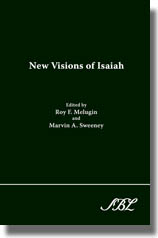
$37.00
This collection of essays arises from the lively discussions of the Formation of the Book of Isaiah Seminar of the Society of Biblical Literature. The essays exhibit the diversity of approach that has always been present in the seminar. Each contributor has a unique perspective and thus extends the frontiers of research on the book of Isaiah. Taken as a whole, the essays fall into two broad groups, being either “objective” in their approach to the text, embracing historical-critical method or a synchronic approach in which text rather than reader is the focus; or “postmodern,” in the sense that meaning is in no small degree located in what the reader does.
“This is a very interesting volume, and particularly beneficial is the interaction between essays that was generated by its seminar context. It contains much about method and hermeneutics as well as offering some interesting insights into the book of Isaiah, both in its parts and as a whole.”
—Katharine J. Dell, Vetus Testamentum
Roy F. Melugin is Research Professor of Hebrew Bible at Brite Divinity School, Texas Christian University, Fort Worth, Texas. Marvin A. Sweeney is Professor of Hebrew Bible at Claremont School of Theology and Professor of Religion at Claremont Graduate University in Claremont, California.
The Book of Isaiah: A Complex Unity: Synchronic and Diachronic Reading
—Rolf Rendtorff
The Book of Isaiah as Prophetic Torah
—Marvin A. Sweeney
Isaiah 28–33: Blest Be the Tie That Binds (Isaiah Together)
—Gary Stansell
Reversals of Fortune in the Ancient Near East: A Study of the Babylon Oracles in the Book of Isaiah
—Chris Franke
Lady Zion’s Alter Egos: Isaiah 47:1–15 and 57:6–13 as Structural Counterparts
—Mark E. Biddle
“Isaiah” as an Exponent of Torah: Isaiah 56:1–8
—Roy D. Wells Jr.
Allusions and Illusions: The Unity of the Book of Isaiah in Light of Deutero-Isaiah’s Use of Prophetic Tradition
—Benjamin D. Sommer
Reading Isaiah from Beginning (Isaiah 1) to End (Isaiah 65–66): Multiple Modern Possibilities
—David McLain Carr
No Strength to Deliver: A Contextual Analysis of Hezekiah’s Proverb in Isaiah 37:3b
—Katheryn Pfisterer Darr
The “Scope” of Isaiah as a Book of Jewish and Christian Scriptures
—Gerald T. Sheppard
Figurative Speech and the Reading of Isaiah 1 as Scripture
—Roy F. Melugin
Prophet, Redactor and Audience: Reforming the Notion of Isaiah’s Formation
—Edgar Conrad
